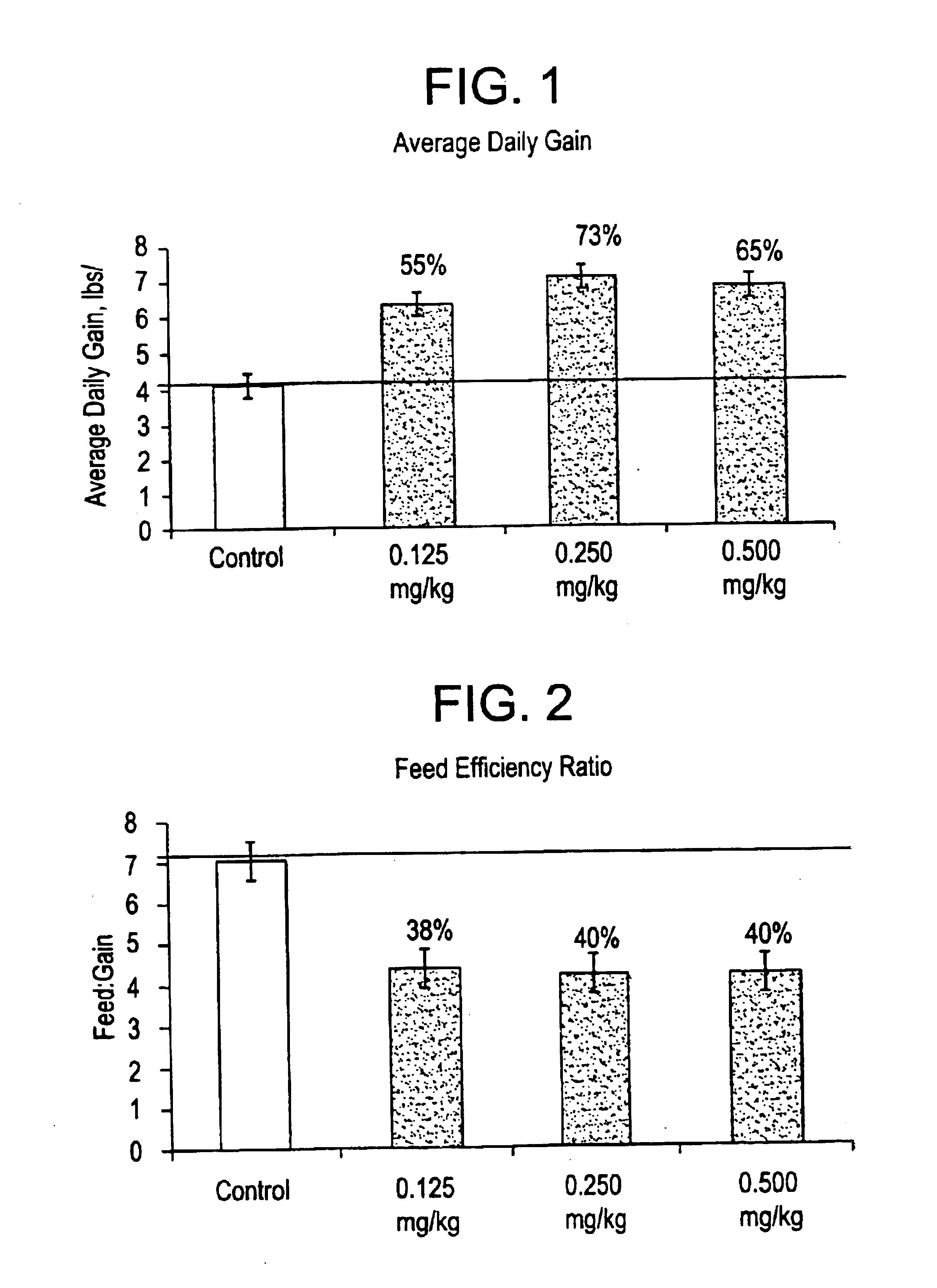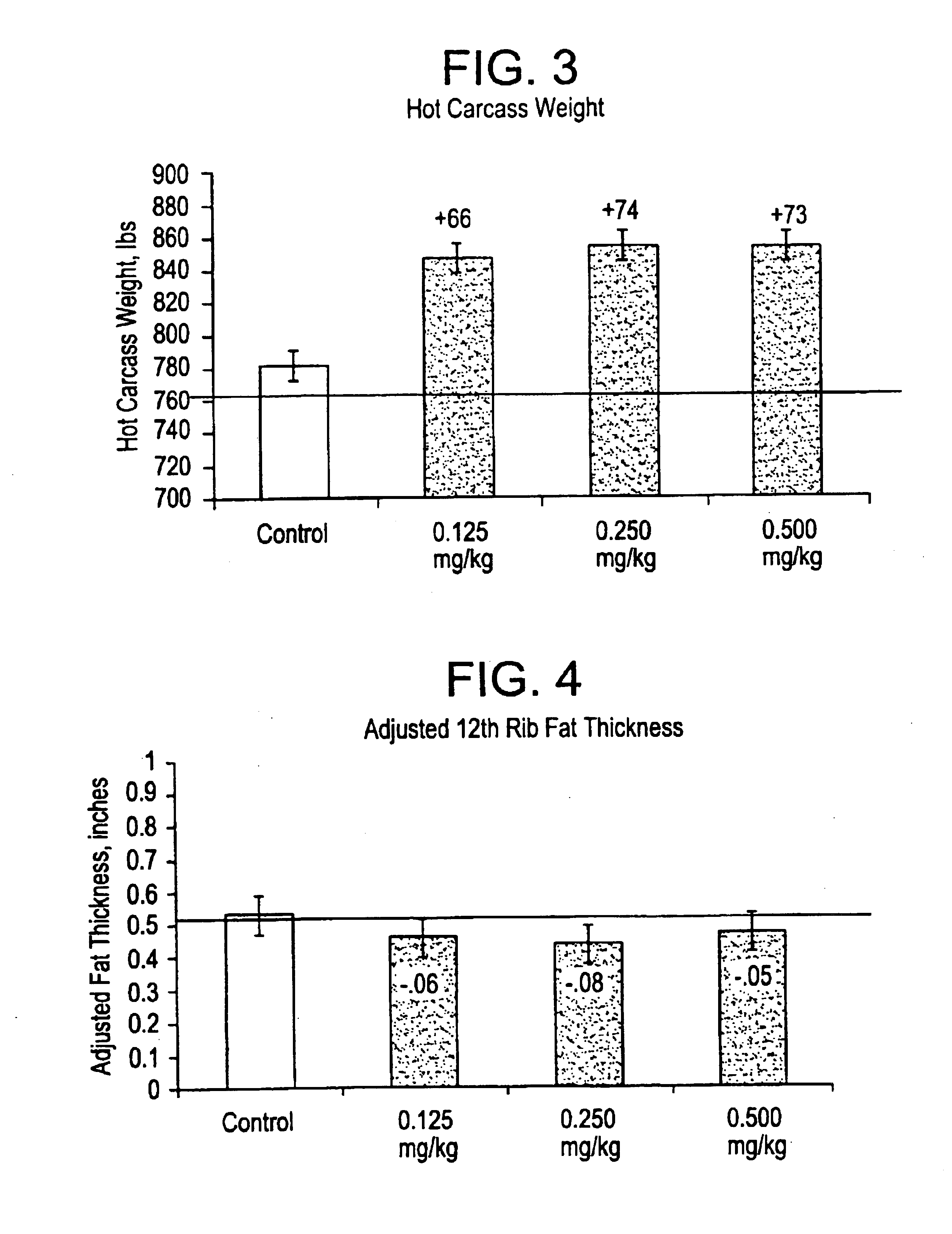Aryloxy propanolamines for improving livestock production
a technology of aryloxy propanolamine and livestock, which is applied in the field of animal husbandry, can solve the problems of minimal nutritional value, increase cholesterol and/or triglyceride levels, and decrease the overall yield of meat, so as to improve live performance parameters, increase muscle, and reduce fat content
- Summary
- Abstract
- Description
- Claims
- Application Information
AI Technical Summary
Benefits of technology
Problems solved by technology
Method used
Image
Examples
example 1
Preparation of 4-[(2S)-Oxiranylmethoxy]-1H-indole
Powdered K2CO3 (40 grams, 289 mmol, 300 mesh) was added to dimethyl sulfoxide (DMSO) (200 mL) containing H2O (4 mL) under N2 at room temperature and the mixture was stirred for 30 minutes. 4-Hydroxyindole (25.2 grams, 189 mmol) was added to the mixture (slight exotherm to 27° C.) and the mixture was stirred for 10 minutes. (S)-Glycidyl nosylate (50.0 grams, 193 mmol, 98.5% ee) was added (slight endotherm). The slurry was stirred for 30 minutes at 20-25° C. and for 23 hours at 25-27° C. until the reaction was complete. The mixture was diluted with acetone (400 mL) and filtered. The cake was washed with acetone (400 mL) and the combined filtrates were concentrated to a volume of ca. 250 mL under vacuum while maintaining the temperature below 35° C. This concentrate was added dropwise, over ca. 2 hours, to deionized H2O (650 mL) held at a temperature of 15-20° C. with an ice / water bath. The product slurry was stirred for 1 hour at this ...
example 2
Preparation of 4-(2-Methyl-2-Nitropropyl)Phenol
Potassium tert-butoxide (29.6 grams, 264 mmol) was added to a solution of 2-nitropropane (260 mL, 2.90 mol), 4-hydroxybenzyl alcohol (65.0 grams, 524 mmol) in diglyme (260 mL) at room temperature with mechanical stirring. During the addition the reaction temperature increased from 25° C. to 39° C. The reaction mixture was heated to reflux and stirred for 6 hours at ca. 137° C., using a Dean-Stark trap to remove the water as it was formed (total volume of distillate 28 mL, 7 mL aqueous phase). After cooling to room temperature, deionized H2O (325 mL) and ethyl acetate (520 mL) were added to the reaction solution. The phases were separated and the organic phase was washed with deionized H2O (2×325 mL) The organic phase was concentrated by rotary evaporation at 78° C. to give 181.2 grams of an oil. This oil was dissolved in methanol (65 mL) for use in the next reaction. The concentration of the resulting solution was determined by 1H NMR ...
example 3
Preparation of the Acetate Salt of 4-(2-Amino-2-Methylpropyl)phenol
To a N2-degassed solution of 4-(2-methyl-2-nitropropyl)phenol (45.0 grams, 230 mmol) in MeOH (450 mL) was added 5% Pd / C (13.5 grams of 50% water-wet catalyst, 15% by weight on a dry-basis). The mixture was pressurized to 35-40 psi with hydrogen and heated to 60° C. with vigorous agitation. When the reaction was complete (ca. 6 hours), the mixture was cooled to room temperature and the catalyst was carefully removed by filtration through Hy-Flow filter aid. The cake was washed with 50° C. methanol (135 mL) and the, combined filtrates were concentrated by rotary evaporation to a net weight of ca. 120 grams. The concentrate was diluted with ethyl acetate (500 mL), and a solution of acetic acid (14.2 grams, 235 mmol) in ethyl acetate (250 mL) was added to the resulting solution over 30 minutes. The resulting slurry was stirred for 2 hours at room temperature. The slurry was filtered and the solid was washed with ethyl a...
PUM
| Property | Measurement | Unit |
|---|---|---|
| lean body mass | aaaaa | aaaaa |
| body mass | aaaaa | aaaaa |
| weight gain | aaaaa | aaaaa |
Abstract
Description
Claims
Application Information
 Login to View More
Login to View More - R&D
- Intellectual Property
- Life Sciences
- Materials
- Tech Scout
- Unparalleled Data Quality
- Higher Quality Content
- 60% Fewer Hallucinations
Browse by: Latest US Patents, China's latest patents, Technical Efficacy Thesaurus, Application Domain, Technology Topic, Popular Technical Reports.
© 2025 PatSnap. All rights reserved.Legal|Privacy policy|Modern Slavery Act Transparency Statement|Sitemap|About US| Contact US: help@patsnap.com



